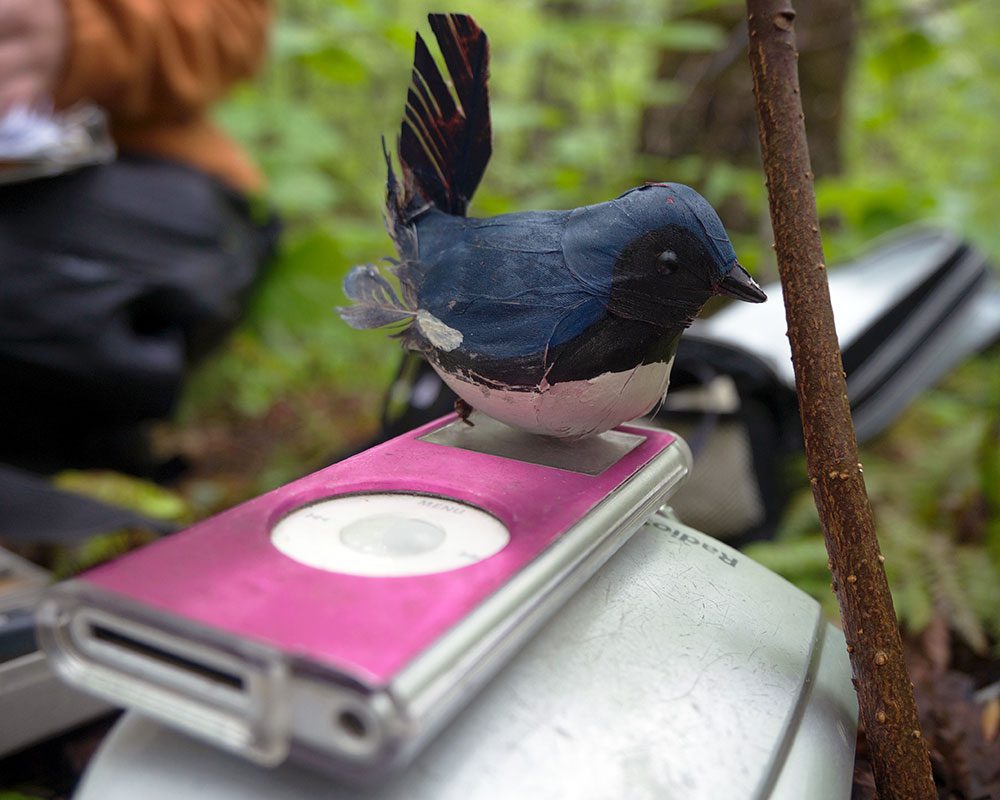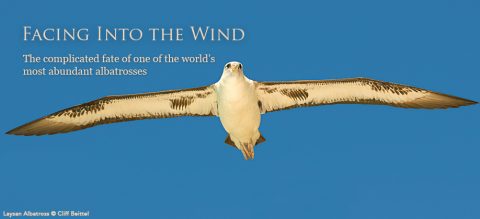Black-throated Blue Warbler: Surprisingly Adaptable to Climate Change
By Gustave Axelson
From the Summer 2014 issue of Living Bird magazine.
Black-throated Blue Warbler by Glenn Bartley via Birdshare July 15, 2014During bird breeding season in New Hampshire’s White Mountains, the frenzy of whistles and twitters and chortles raining down from the treetops—the full-throated voices of tanagers and thrushes and assorted warblers—creates a wall of sound at a trailhead. Step inside, and you’re immersed in bird song.
But it was a very hushed zoo-zoo-zeee from the hobblebushes on the forest floor that stopped Cornell Lab researcher Sara Kaiser in her tracks. She pulled back the hood of her rain jacket and listened intently. “That’s a Black-throated Blue Warbler’s whisper song,” she explained. “Acoustic mate guarding. A male guarding his mate.”
The territories of Black-throated Blue Warblers, and indeed the core of their range, are undergoing extensive change these days. The annual average temperature in the forests of the Northeast rose by 1.44 degrees Fahrenheit between 1900 and 1999, and that average temperature is forecast to continue rising for the next 100 years—ranging from increases of more than 5 degrees if greenhouse gas emissions are curtailed to almost 10 degrees in a higher-emissions scenario.
Over the past seven years, Kaiser has conducted research on Black-throated Blue Warblers at the Hubbard Brook Experimental Forest that may offer a ray of hope for the species in this century. Kaiser’s studies of more than 1,000 blackthroated blues show that they can adapt their breeding behavior across climates spanning an elevation range of 600 meters, with a difference in climate between higher and lower elevations approximating the change in the lower-emissions scenario.
In other words, Black-throated Blue Warblers may be able to weather climate change just fine, if humans cut emissions and limit future warming. Zoo-zoo-ZEE! This black-masked, midnight-blue male was not whispering. He was clearly agitated as Kaiser, clipboard and data sheet in hand, approached his mate’s nest beneath the leaves of a hobblebush. “This female’s eggs were covered in a freak late-spring snowstorm just a few days ago,” Kaiser whispered. “But she seems to be doing fine right now.”
This much Kaiser knew going into the project—Black-throated Blue Warblers appear to be very rigid in their spring migration, always arriving here in the first week of May. Such rigidity in breeding behavior would presumably not bode well for coping with climate change.
But Kaiser’s research shows that black-throated blues actually run through a matrix of options and decision-making as they survey the conditions around them each breeding season. If they are able to nest in higher elevations where caterpillars abound and food is plentiful, black-throated blue males settle into their territories and spend more time guarding their mates from other interloping males, thereby defending their paternity. These males may be more likely to cheat during the parental stage (because food is plentiful, the females are less likely to need help with their offspring). While she tends the nest, he wanders off to attempt siring offspring with nearby females. These males in high-quality habitat are also more likely to pursue a second brood with their mate in the summer, potentially doubling their annual reproductive output.

Black-throated blue males in lower elevations with fewer caterpillars and poorer-quality habitat make different decisions. They are forced to spend more time feeding themselves while their mates are fertile (because food is relatively scarce), so they leave themselves open to cuckoldry. They are far less likely to attempt a second brood.
When Kaiser introduced a variable, providing mealworms and waxworms to the nesting black-throated blues in poor quality habitats, something fascinating happened. The birds adjusted their breeding strategy mid-season. Now the males stayed home and guarded their mates when they were fertile, to protect their paternity. They also raised a second brood with their mates.
The significant finding from all this peering into the lives of Black-throated Blue Warblers: their breeding behavior is not hard-wired into their DNA. They can respond and cope with moderate environmental change (even moderate change introduced rapidly within a given year).
“With climate change, we expect changes in food availability,” said Kaiser. “We showed that Black-throated Blue Warblers are able to adjust to small changes and still achieve high reproductive success.”
Even better news, this flexibility in breeding behavior may not exist solely among black-throated blues but could be shared among several species of Neotropical migratory songbirds. Many other warblers may be able to cope with climate change that affects their northern range— in a lower-emissions scenario.
Reference
Kaiser, S. A., T. S. Sillett, B. B. Risk, and M. S. Webster. 2015. Experimental food supplementation reveals habitat-dependent male reproductive investment in a migratory bird. Proceedings of the Royal Society B: Biological Sciences 282:20142523.
Kaiser, S. A., T. S. Sillett, and M. S. Webster. 2014. Phenotypic plasticity in hormonal and behavioural responses to changes in resource conditions in a migratory songbird. Animal Behaviour 96:19–29.

All About Birds
is a free resource
Available for everyone,
funded by donors like you
American Kestrel by Blair Dudeck / Macaulay Library



